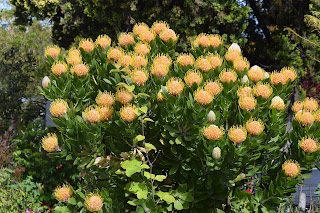Well, it may have been a drag putting up with rain day after day throughout the winter and early spring but now we see the rewards for this endurance. That rain has caused a flush of new growth on our deciduous shrubs and trees and given smaller perennials a chance to develop sturdier roots. Now with sun and warmer weather, many plants have burst into bloom. Today's photos give an idea of the breadth of this newfound floral joy. That said, here they are.
One of the stars of this year's garden has been the Ixia paniculata 'Eos'. It looks especially great in a thicket of bulbs.
Marmalade bush always draws attention when it's in bloom. Hummingbirds and titmice love the nectar they source from its flowers.
Leuco spermum 'Veldfire' likewise has that wow factor when it is in bloom. Bees love the flowers.
My Papaver 'Scarlet peony' breadseed poppy is spectacular this year.
I've forgotten the name of this Mimulus variety. Pale yellow and white flowers. So pretty and it's a CA native.
My Aloes are in bloom, including this smaller-sized one.
I'm not sure but I think this geranium might be G. incanum 'Sugar Plum.' It's vigorous and tenancious!
Aloe striata (Coral aloe). Aloe flowers are a great source of nectar for hummingbirds.
This hard to find Phacelia tanacetifolia (Lacy phacelia) is a beauty and a favorite destination for bees and butterflies.
Clematis 'Niobe' has one of the richest flowers in the clematis world.
Although most people think the common name 'Mock orange' refers to Philadelphus species, Choisya ternata also exhibits that wonderful citrus fragrance. Here's Choisya 'Sundance', known for its golden foliage.
Scabiosa 'Harlequin.' This ground cover Scabiosa attracts beaucoups of bees and butterflies.
Echium 'Blue Bedder' may be an annual but it's still a bee magnet and it self-seeds readily!
Tho most people think that all honeysuckles are fragrant, some aren't. This Lonicera x americana makes up for that fact by producing millions of very lovely flowers.
Nigella variety. Love-in-a-Mist flowers can be pink, blue or white but most people prefer this sky blue color.
The rain has definitely benefited my Smoke tree. It flushed out full and already has it's first 'smoke' flower puffs.
The photo above and below are those of an unidentified Ornithogalum (Star of Bethlehem). This vigorous bulb can have white, yellow or orange flowers.
The more common Salvia africana-lutea has brown flowers but this 'cousin', S. africana-caerulea has lavender-colored blooms.
Here's another photo of my Crimson peony breadseed popppy. Notice how dense with petals it is.
There are many interesting species Impatiens out there and one of them is I. usambarensis. It's a prolific bloomer, as you can see here.
I have many, many lilies and the first to bloom are usually the Asiatic types. Here's an Asiatic called 'Lionheart.'
My Bronze fennel is off and running. Now I have my eyes trained for the first Anise Swallowtail caterpillars.
Everybody loves sweet peas ...
One of the 'old world' Clematis, this C. 'Belle of Woking' is uniquely charming.
It's hard to see but this little Sedum species is housed in a decorative blue teacup planter.
This barrel cactus has sprouted its first flowers.
Peanut cactus seems an apt common name for this cactus.
I like this wood planter and it currently holds a couple of Blechnum ferns.
The rain also benefited my Rhododendron 'Sappho'. It's having its best blooming year ever.
Viburnum plicatum. I love the ridged, bright green leaves on this Viburnum as much as I do its flowers.
Wonga Wonga vine is the common name for this Pandorea pandorana.

































No comments:
Post a Comment